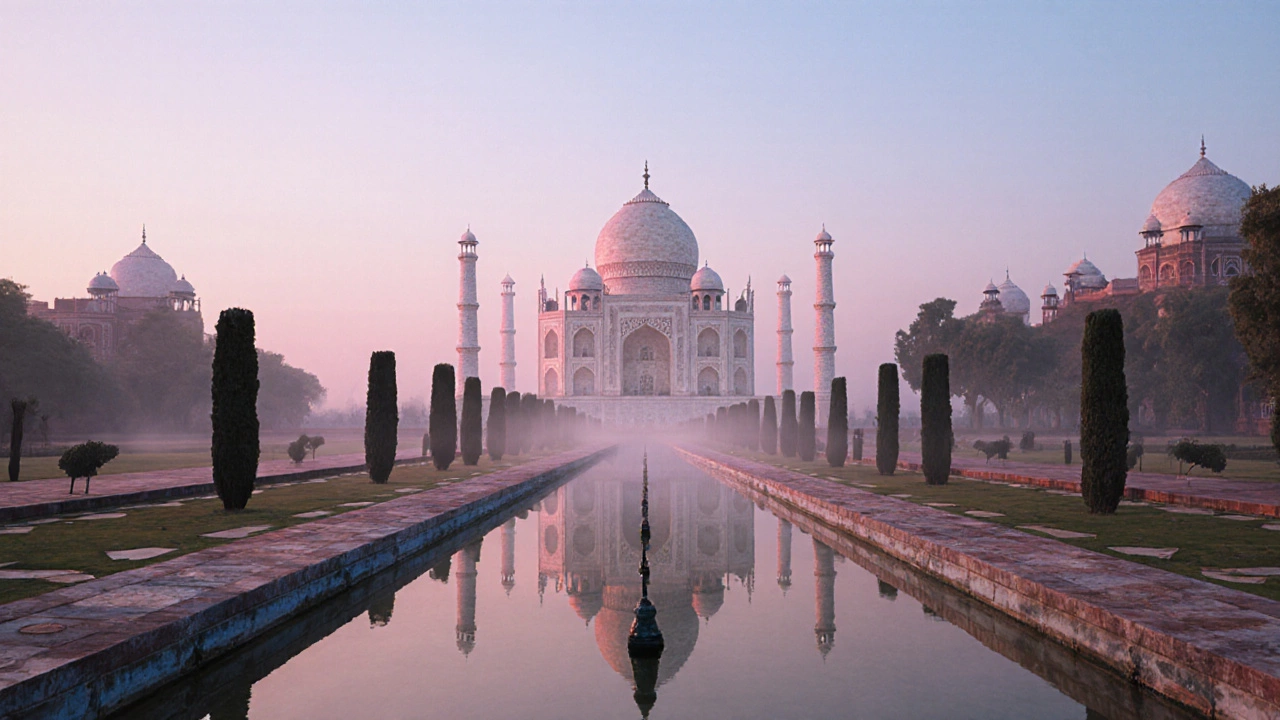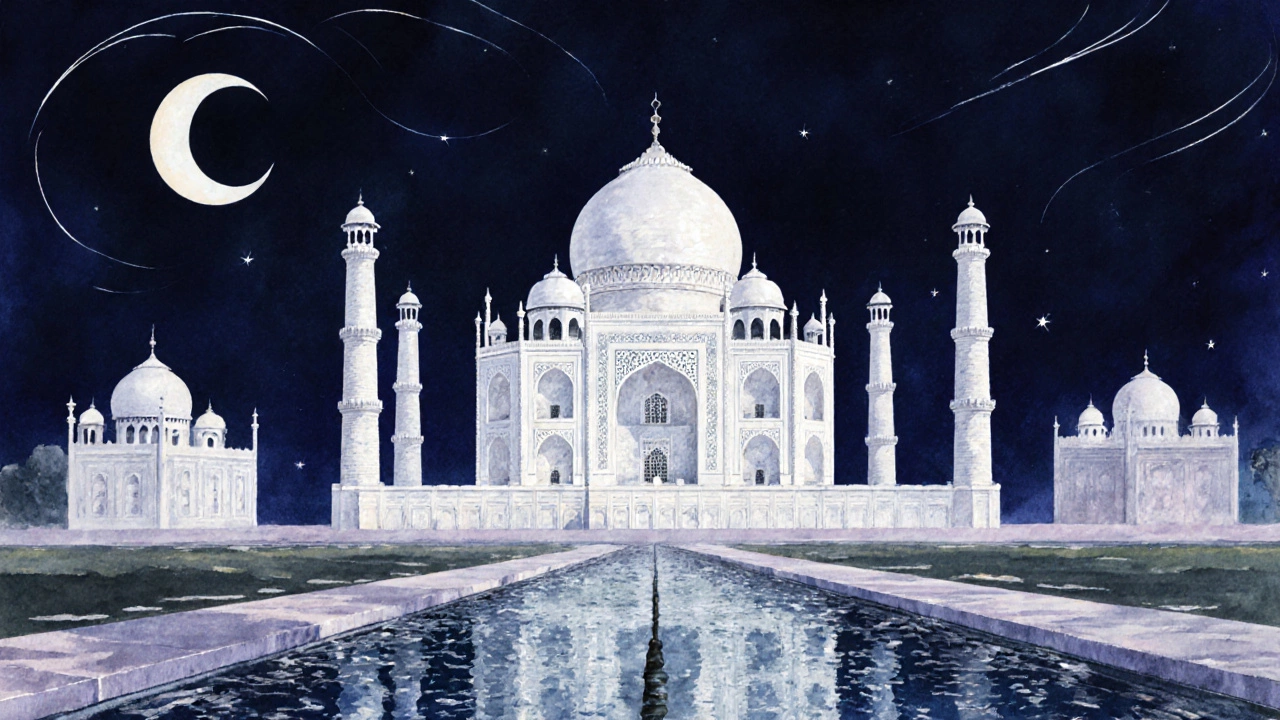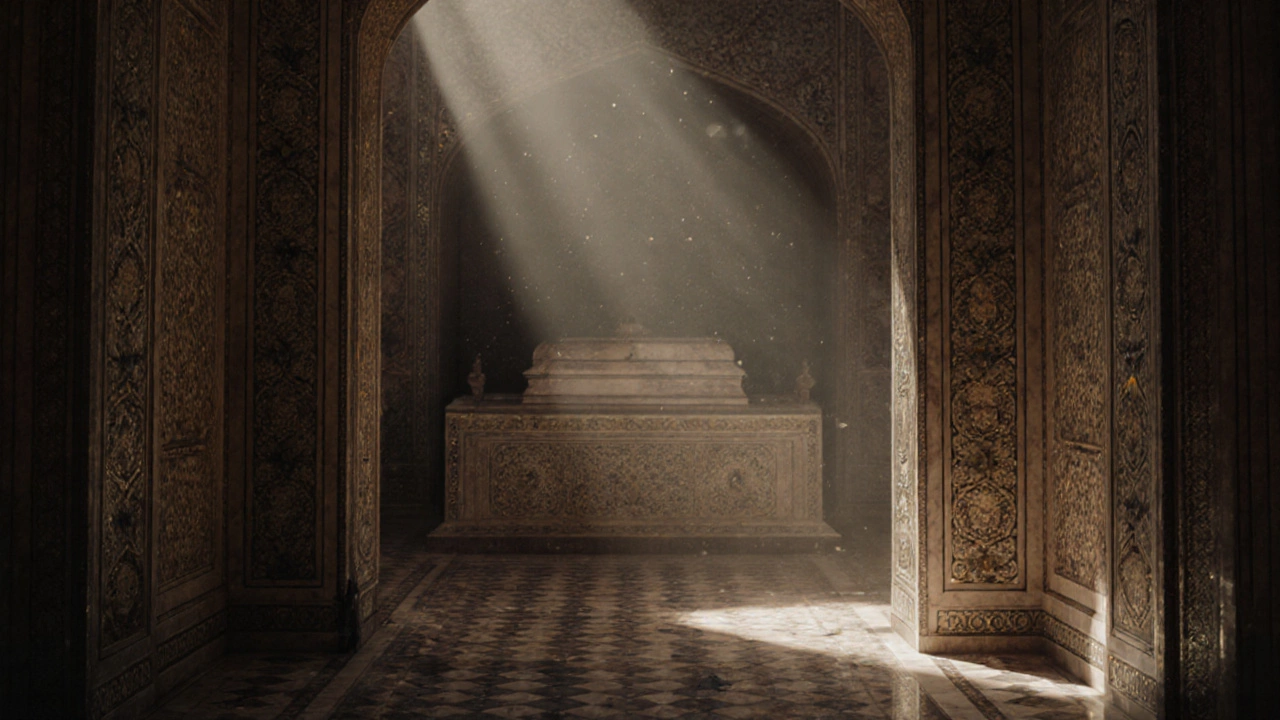Most Beautiful Historical Place in India: Where History Meets Wonder
 Nov, 1 2025
Nov, 1 2025
Taj Mahal Visit Optimizer
Visit Planning
Weather Conditions
Based on your visit date
Clear sky, 25°C (77°F)
Optimal Visit Recommendations
For your visit on , the Taj Mahal will be at its most magical during when crowds are minimal and marble reflects perfect light.
Your estimated ticket cost:
There’s no shortage of ancient cities, crumbling forts, and sacred temples across India. But if you’re asking which single historical place stands out as the most beautiful, the answer isn’t just about architecture-it’s about emotion. It’s about the way light hits white marble at sunrise, the silence that falls over crowds when they first see it, and the fact that millions still travel across the world just to stand in its shadow. That place is the Taj Mahal.
Why the Taj Mahal Isn’t Just Another Monument
The Taj Mahal wasn’t built to impress kings or showcase power. It was built because a man lost the love of his life. When Mumtaz Mahal died giving birth to their 14th child in 1631, Emperor Shah Jahan didn’t just grieve-he built a tomb so stunning, it became a global symbol of devotion. Over 20,000 workers spent 22 years crafting it. They brought white marble from Rajasthan, jade from China, turquoise from Tibet, and lapis lazuli from Afghanistan. Every detail was chosen for meaning, not just beauty.
Unlike other historical sites that feel like relics, the Taj Mahal still breathes. The marble changes color with the sun: soft pink at dawn, brilliant white at noon, golden at sunset. At night, under moonlight, it glows like a pearl. That’s not a trick of photography-it’s real. The stone absorbs and reflects light differently because of its high quartz content. No other structure in India does this.
What Makes It More Than Just a Pretty Building
People often compare the Taj Mahal to the Pyramids or the Colosseum. But those are feats of engineering. The Taj is a feat of feeling. It’s symmetrical in every way-except one. Shah Jahan’s own tomb, placed beside Mumtaz’s, breaks the perfect balance. He never intended to be buried there. But when he died, his son placed him next to her. That tiny asymmetry turns the whole complex into a quiet, heartbreaking truth: even perfection can’t outlast love.
The gardens around it? Designed to mirror Islamic paradise. Four water channels represent the rivers of life, death, joy, and sorrow. The reflecting pool doesn’t just show the building-it makes it feel like the sky is holding it. Walk through the gate, and the Taj doesn’t rush to meet you. It reveals itself slowly, like a poem unfolding line by line.
Other Strong Contenders-And Why They Fall Short
Some will argue for the Amber Palace in Jaipur, with its mirror halls and hilltop views. Others will say the Khajuraho temples, with their intricate carvings of gods and lovers. Agra Fort, nearby, is massive and powerful. But none of them carry the same weight.
Amber Palace feels like a royal vacation home. Khajuraho is awe-inspiring, yes-but its carvings are more about mythology than emotion. Agra Fort is impressive, but it’s a fortress. It tells stories of war, not love. The Taj Mahal is the only site in India where you feel the presence of a human heart beating through stone.
Even UNESCO, which lists over 40 heritage sites in India, calls the Taj Mahal “a masterpiece of human creative genius.” Not “one of.” Not “among the.” The wording is intentional. It’s the only one given that exact title.

When to Go-and When to Avoid
If you want to see the Taj Mahal at its most magical, go at sunrise. The gates open at 6 AM, and by 6:30, the first rays hit the dome. Crowds are thin. The air is cool. You can stand in front of the reflecting pool and have the whole place to yourself for ten minutes. That’s when you understand why poets and photographers keep coming back.
Avoid midday in summer. Temperatures hit 45°C (113°F), and the marble gets too hot to touch. Winter, from November to February, is ideal. Days are clear, the air is crisp, and the sky stays a deep blue. Even better-visit on a full moon night. The Taj opens for limited night viewing, and the glow is unlike anything else on earth.
What You’ll See Beyond the Main Dome
Most visitors focus only on the central mausoleum. But the whole complex is worth hours. The mosque on the west side is made of red sandstone, built for prayer. The guest house on the east balances it visually. Both are functional, not just decorative.
Inside the main chamber, the cenotaphs are ornate. But the real graves lie underground, plain and simple, just as Islamic tradition demands. The marble screens around them are carved so finely you can see light pass through them like lace. Each panel took months to finish.
Walk the perimeter. Notice how the minarets lean slightly outward. That was intentional. If they ever fell, they’d fall away from the tomb. That’s the kind of detail that separates greatness from brilliance.
Why This Place Still Matters Today
In a world of fast travel and Instagram snapshots, the Taj Mahal forces you to slow down. You can’t take a good photo of it without standing still. You can’t feel it without being present. It doesn’t shout. It doesn’t need to. It simply is.
Every year, over 7 million people visit. Many come for the history. Some come for the romance. But the ones who truly leave changed? They come for the silence. The kind of silence that follows awe. The kind that makes you forget your phone, your schedule, your worries. That’s why, after 390 years, it’s still the most beautiful historical place in India. Not because it’s the oldest. Not because it’s the biggest. But because it’s the only one that makes you feel something deeper than admiration.

How to Make the Most of Your Visit
Book tickets online in advance. The government limits daily visitors to 40,000, and tickets sell out, especially for sunrise slots. Use the official website-no third-party vendors.
Wear comfortable shoes. You’ll walk over 2 kilometers inside the complex. Bring water. There are no food stalls inside the main grounds. Carry a small bag-large backpacks aren’t allowed.
Consider hiring a local guide for 500-800 rupees. They’ll tell you stories no brochure can. Like how the calligrapher who wrote Quranic verses on the walls signed his work in invisible ink, so his name wouldn’t distract from the divine message.
What to Do After the Taj Mahal
If you’re in Agra, don’t leave without seeing Agra Fort. Just 2.5 kilometers away, it’s a red sandstone palace where Shah Jahan spent his final years, gazing at the Taj from his prison window. The view from the Musamman Burj tower is the same one he saw-quiet, haunting, and achingly beautiful.
Or take a day trip to Fatehpur Sikri, the abandoned Mughal capital 40 kilometers away. Its empty courtyards and silent mosques feel like a ghost town of grandeur. It’s quieter, less crowded, and just as stunning.
Is the Taj Mahal the only beautiful historical place in India?
No, India has dozens of stunning historical sites-from the stepwells of Gujarat to the rock-cut caves of Ellora. But the Taj Mahal is the only one that combines perfect architecture, deep emotional meaning, and universal recognition in a way that moves people across cultures and centuries. It’s not just beautiful-it’s unforgettable.
Can you go inside the Taj Mahal?
Yes, you can enter the main mausoleum. But you must remove your shoes and walk barefoot on the marble floor. Only small bags are allowed inside. Photography is permitted, but tripods and drones are banned. The interior is dimly lit to protect the marble inlay work, so don’t expect bright views.
How much does it cost to visit the Taj Mahal?
Foreign tourists pay 1,300 Indian rupees (about $15 USD) for entry. Indian citizens pay 50 rupees. Children under 15 enter free. Night viewing tickets cost 750 rupees and are only available on full moon nights and two days before and after. Tickets are non-refundable and must be booked online.
Is the Taj Mahal really made of marble?
Yes, the main structure is built from Makrana marble, quarried in Rajasthan. It’s pure white and highly reflective. The intricate floral patterns are made from semi-precious stones like lapis lazuli, carnelian, and jade, inlaid into the marble using a technique called pietra dura. This method required artisans to cut each stone piece by hand to fit perfectly.
Is the Taj Mahal one of the Seven Wonders of the World?
Yes. In 2007, after a global poll of over 100 million votes, the Taj Mahal was officially named one of the New Seven Wonders of the World. It’s the only site from India on that list. It also holds UNESCO World Heritage status, awarded in 1983, and is consistently ranked as the most visited monument in South Asia.
Final Thought: Beauty That Lasts
India has temples older than Rome, forts taller than castles, and cities that have stood for millennia. But none of them make you pause-really pause-like the Taj Mahal. It doesn’t just survive history. It makes you feel it. And that’s why, no matter how many times you’ve seen it in pictures, standing there in person still takes your breath away.